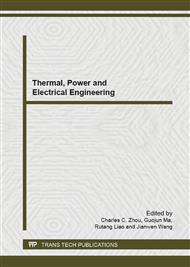[1]
Min Tu a,*, Cheng-Qin Ren b, Guang-Fa Tang a, Zhen-Sheng Zhao. Performance comparison between two novel configurations of liquid desiccant air-conditioning system. Building and Environment.45(2010):2808-2816
DOI: 10.1016/j.buildenv.2010.06.009
Google Scholar
[2]
Gommed K, Grossman G. Experimental investigation of a liquid desiccant system for solar cooling and dehumidification. Sol Energy.81 (2007):131-8.
DOI: 10.1016/j.solener.2006.05.006
Google Scholar
[3]
Gommed K, Grossman G. A liquid desiccant system for solar cooling and dehumidification. J Sol Energ e T ASME.126(2004):879-85.
DOI: 10.1115/1.1690284
Google Scholar
[4]
Ameel TA, Gee KG, Wood BD. Performance predictions of alternative low cost absorbents for open-cycle absorption solar cooling. Sol Energy. 54(2) (1995):65-73.
DOI: 10.1016/0038-092x(94)00103-k
Google Scholar
[5]
Jain S, Dhar PL, Kaushik SC. Experimental studies on the dehumidifier and regenerator of a liquid desiccant cooling system. Appl Therm Eng .20(2000):253-67.
DOI: 10.1016/s1359-4311(99)00030-7
Google Scholar
[6]
Kinsara AA, Al-Rabghi OM, Elsayed MM. Parametric study of an energy efficient air conditioning system using liquid desiccant. Appl Therm Eng.18(5)(1997):327-350.
DOI: 10.1016/s1359-4311(97)00037-9
Google Scholar
[7]
X..H. Liu, Y.Jiang, X.M. Chang, X..Q.Yi,Experimental investigation of the heat and mass transfer between air and liquid desiccant in a cross-flow regenerator. Renewable Energy 32 (2007) 1623-1636
DOI: 10.1016/j.renene.2006.07.002
Google Scholar
[8]
D. Pietruschka, U.Eicker, M.Huber, J. Schumacher, Experimental performance analysis and modelling of liquid desiccant cooling systems for air conditioning in residential buildings. International Journal of Refrigeration 29 (2006) 110–124
DOI: 10.1016/j.ijrefrig.2005.05.012
Google Scholar
[9]
J.Gu,J.J. Wen Z.C. Tian, Experimental research on dehumidifier using LiCI solution as liquid desiccant.Transactions of the CSAE. 22 (2006) 121-124
Google Scholar
[10]
J.Sun, M.H. Shi, Study on Coefficient of Performance of Solar Liquid Desiccant Air-conditioning System. FLUID MACHINERY. 35 (2007).61-66
Google Scholar
[11]
Q.Zhang, J.H. Liu, Z.M.Wu, W.Z. Gao, Experimental Investigation and System Analysis of a Novel Liquid Desiccant Air-conditioning System. ACTA ENERGIAE SOLARIS SINICA. 30 (2009) 294-298
Google Scholar
[12]
G.A. Longo , A.Gasparella. Experimental and theoretical analysis of heat and mass transfer in a packed column dehumidifier/regenerator with liquid desiccant. International Journal of Heat and Mass Transfer 48 (2005) 5240-5254
DOI: 10.1016/j.ijheatmasstransfer.2005.07.011
Google Scholar
[13]
C.G. Moon, P.K. Bansal, S.Jain. New mass transfer performance data of a cross-flow liquid desiccant dehumidification system.International Journal of Refrigeration.32(2009):524-533
DOI: 10.1016/j.ijrefrig.2008.06.011
Google Scholar
[14]
M.R. Conde. Properties of aqueous solutions of lithium and calcium chlorides: formulations for use in air conditioning equipment design. International Journal of Thermal Sciences 43 (2004):367–382
DOI: 10.1016/j.ijthermalsci.2003.09.003
Google Scholar


